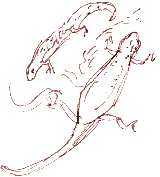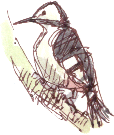previous | home page | this month | next
Sunfly
Richard Bell’s Wild West Yorkshire nature diary Sunday, 8th June 2008
previous | home page | this month | next
4.20 p.m., temp. 28°C
THE QUESTION that I’m asking is does this hoverfly have a black stripe down the yellow on its face? I’m field testing my new copy of Collins Complete Guide to British Insects. Obligingly, the hoverfly immediately perches on some kingcup seeds, facing towards me and, yes, the stripe is clearly visible.










That makes this Helophilus pendulus (or hybridus: to tell the difference between those guys I’d need to see its hind tibia!). Helophilus sounds as if it means that it loves the sun and, sure enough, another book dubs it the ‘Sunfly’.
They seem to be territorial, four or more are perching around the pond, chasing each other regularly.
Its young, known as rat-
Waterboatmen
According the the Guide, we’ve got backswimmer waterboatmen, Notonecta glauca, in our pond, but ours come in a range of sizes, so perhaps the smaller one, which sticks to the weedier patches, is another species.
Wolf Spider
Here’s another sun-
She pauses on a floating leaf and holds her silken parcel in the sun, moving around as if to incubate the eggs more evenly.
I’m trying to focus on insects this afternoon but a female woodpecker flies into next door’s sumac six yards from me, so I have to draw her. We’ve been hearing a woodpecker drumming on and off all afternoon.
Smooth Newts
It’s good to see so many smooth newts in the pond. Females are plump with eggs, the males in bright breeding colours, curling their tails like pennants in their courtship dance.
Trying to clear a shady spot for a garden chair this morning I disturbed 3 young
newts -